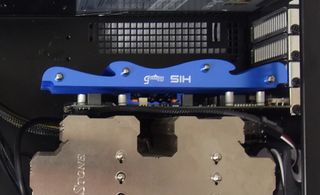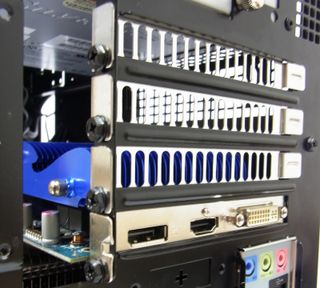Silent, But Deadly: Build Your Own Gaming-Ready 0 dB PC
For many folks, the most beautiful sound that a PC can make is no sound at all. How close can Tom's Hardware get to a zero-decibel configuration and still lend up with a compact, functional machine capable of mainstream gaming, without breaking the bank?
Adding Some Graphics Power
It’s hard to run several passively-cooled components in a small case like SilverStone's Temjin TJ08-E. Nevertheless, in addition to the build you just read about, we're benchmarking three different graphics setups: a HIS Radeon HD 7750 iSilence 5, Sparkle's GeForce GTX 650 OC that we modified for passive cooling, and a dual-GPU setup with CrossFire consisting of AMD's A10-5700 APU and a passive HIS Radeon HD 6670 iSilence 5.
Let's be clear: a small, enclosed system like this does reach its limits pretty quickly when an APU and discrete graphics card are taxed at the same time, dissipating 100 W+ of heat (particularly in the warmer summer months). But we think we have a solution for maintaining the integrity of our silent system for the most part. With a bit of tinkering, we added a quiet fan that only kicks on when it's needed. A good motherboard can control the blower through its firmware. Or, alternatively, a thermal switch does the same job. We’ll show you how to install a switch like this later in the story. For now, though, let’s get back to the build.
Silent and Efficient GCN
We’ve talked about HIS' Radeon HD 7750 iSilence 5 before. It features one of the most powerful GPUs you can find that can still be cooled passively. While Sapphire and PowerColor offer similar cards, all of them should function comparably.

The graphics card sits above our CPU cooler, obstructing some of its airflow and reducing its cooling performance a bit. The hit isn't massive, but it's certainly obvious when the system is pushed to its limit. If you already know going into this project that you'll be using discrete graphics, then an Ivy Bridge-based platform is almost certainly the way to go. That'll bring your temperature down about five degrees Celsius compared to the APU-based config.
Graphics Benchmarks
The Radeon HD 7750 easily competes with the other graphics solutions we're testing, and it offers the highest efficiency by offering the best performance for the power it uses. Nvidia's GeForce GTX 650 is roughly as fast.
Stay on the Cutting Edge
Join the experts who read Tom's Hardware for the inside track on enthusiast PC tech news — and have for over 25 years. We'll send breaking news and in-depth reviews of CPUs, GPUs, AI, maker hardware and more straight to your inbox.
But before we get into the details of that little project, let's have a look at the cumulative benchmark numbers with a Core i7, a Pentium G2120, and AMD's A10-5700. The performance index and benchmarks come from our 2012 graphics charts, and we used that machine's image for the AMD A10-5700-based build.

Bottom Line So Far
For a passively-cooled system, this thing's gaming performance isn't bad. It gives us high-enough frame rates for 1920x1080 in many cases, so long as graphics details are turned way down. Temperatures are also acceptable, though anyone building this PC should check them out anyway, just to be on the safe side.

Current page: Adding Some Graphics Power
Prev Page Operation, Benchmark, And Bottom Line Next Page Building A Passive Nvidia GeForce GTX 650-
azathoth I was disappointed there wasn't actual stress test temperature results of the APU for the passive cooling solution.Reply
But otherwise it's a neat article, personally I would sacrifice dead silence to use a cheaper HDD and perhaps more of those silent fans if I were to build one myself. -
Nintendo Maniac 64 As someone that also uses a semi-passive PC (fan only turns on when needed), I'm disappointed that you guys left out a few big things:Reply
1. undervolting the CPU and GPU
2. underclocking and farther undervolting the GPU for 2D mode
3. hybrid cooling setup for GPUs where the fan only turns on at a high temperature (may require GPU BIOS editing depending on GPU model)
OPTIONAL (due to risk): removal of CPU IHS -
Madn3ss795 Pentium G2120 + Sapphire Ultimate HD7750 would have been a better choice. And you can pay extra for a low-power Core i5 instead since it's not that expensive compared to the rest of this build.Reply -
ivyanev When i hear gaming from the TH I really expect to see something in the realm of 500$ SBM machine or at least something close. What I see here is realy nice office pc.Reply -
Nintendo Maniac 64 Reply
The main issue is the GPU, and that would require a hybrid passive-active cooling solution much like was done for the CPU, but for some reason they didn't even try such a thing...10589934 said:When i hear gaming from the TH I really expect to see something in the realm of 500$ SBM machine or at least something close. What I see here is realy nice office pc. -
twelve25 I wonder about an i5 or i7 S or T model and crossfire 7750's. You might need a bigger case and a longer motherboard that allows gaps between cards.Reply
